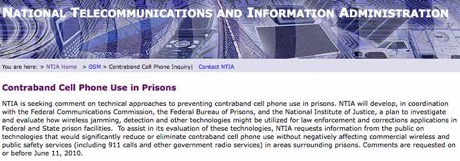NTIA NOI on Prison Cell Phone Use

Wednesday’s Federal Register contained an NOI from NTIA entitled “Preventing Contraband Cell Phone Use in Prisons”. FCC has been sitting on without any visible action a related Petition for Rulemaking from 30+ state corrections agencies that was filed on 8/6/09. Oddly, the NTIA NOI never mentions this petition either.
NTIA’s action here come from 12/09 language in the Conference Report to the Department of Commerce FY 2010 Appropriations (p. 619) tasking NTIA, in coordination with the FCC, BOP, and NIJ, to develop a plan to investigate and evaluate how wireless jamming, detection, and other technologies might be utilized for law enforcement and corrections applications.

Footballs modified to serve as carriers for cell phones and thrown over a prison fence
The NOI identified “three categories of contraband cell phone intervention: jamming, managed network access, and detection.”
On jamming, the NOI cites the opposition of CTIA and APCO and says “Stating that it did not have the authority to permit such jamming, the FCC has denied the petitions.” In reality, the whole Commission has never taken any such action or even spoken on the topic. There have been staff actions, such as those cited in the NOI, where the staff indicated a lack of authority and it is pretty clear that no present FCC rule authorizes jamming. But neither NTIA nor CTIA have ever cited an action by the whole Commission that interprets §333 as forbidding the Commission from ever authorizing jamming in a rulemaking. The 8/09 Petition reviews the legislative history of §333 and argues that CTIA’s interpretation in incorrect. While this petition has never been even put on public notice for formal comment, it is on file in Docket 09-30 and the cellular establishment has never publicly addressed it contents - no doubt preferring smoke filled rooms on the Hill and off the record discussion with FCC and NTIA officials (clearly permissible under ex parte rules in this case.)

Packages with cell phones that didn’t make it over the prison fence and got trapped in razor wire
Here are the questions NTIA asks:
Are these characterizations accurate and complete?
Are there technologies other than these categories, and if so, how do they work?
What approaches can be taken to jam within irregular structures such as prisons, within indoor and outdoor areas and within rural versus urban settings?
What specific types of managed access and detection techniques are available?
What risk does each system pose to legitimate cell phone use by the general public outside the prison?
What risk does each system pose to public safety and government use of spectrum?
How can any of the foregoing risks be mitigated or eliminated?
What are the benefits and drawbacks of implementing these techniques?
Are certain systems more suitable for certain prison environments or locations?
To what extent does the installation of each system require a customized approach for each prison?
How disruptive is the installation process?
What approaches can be used in the implementation of systems employing detection techniques?
How does each system provide for completion of critical calls or radio communications such as those from public safety officers (including use of handheld two-way radios) or 911?
What ability does each of these technologies possess for upgrades to include new frequency bands, technologies, modulation techniques, etc. as they are introduced into the marketplace?
How quickly can they be upgraded?
NTIA does not ask about how these systems should be paid for. As your blogger’s client, Soth Carolina Department of Corrections indicate in a 10/09 letter to FCC , approaches like managed access perform functions that both deny service to contraband cellphones and facilitate legitimate calls. Should the cellular carriers therefore pay at least part of the system cost? The letter also points out that managed access will only work if the carriers have an obligation to notify whoever operates them of any pending change to their air interface that could impact their operation and delay implementation until the access system is modified. While AT&T and BOCs had analogous wireline obligations in the 1980s, does the cellular industry want that today?
The NOI states
.The longstanding radio spectrum regulation principle, embodied in the Communications Act of 1934, is to preclude harmful interference and not to block access to or receipt of information transmitted wirelessly. In addition to producing emissions in specific bands and within specific areas to deny service,jamming systems also produce unwanted signals outside of their intended operating bands and are not naturally confined to a prescribed area. These signals have the potential to produce interference to other radio services operating in numerous frequency bands (including Federal Government operations) and outside of the prison facility. (emphasis added)
NTIA - why are jammers different than any other radio transmitter in this respect? Don’t all transmitters produce “unwanted signals outside of their intended operating bands”? Why do other types of systems have emissions that “are confined to a defined area’”, thus going certain distances and then magically stopping? Why won’t the basic framework NTIA itself has adopted to protect GPS systems in §8.3.28 of the NTIA “Red Book” work for cell phones jammers? Do GPS signals have fundamentally different physics?




![Validate my RSS feed [Valid RSS]](valid-rss-rogers.png)

